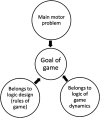How to understand sports and traditional games and how to apply it to physical education. On the "Goal of Game" - PubMed (original) (raw)
How to understand sports and traditional games and how to apply it to physical education. On the "Goal of Game"
J P Ribas et al. Front Sports Act Living. 2023.
Abstract
Introduction: Does philosopher's stone exist in physical education? It could be said that teaching games for understanding approach (TGfU) keeps turning everything it touches into gold: its presence in the educational centers, its volume of publications, the way of teaching games and sports, its connections with other approaches, its game categories, learning transferable principles of play. But… no, all that glitters is not gold. There are TGfU issues that should be improved. For example, these categories are disconnected from each other because TGfU lacks classification criteria. The "goal of game" is a concept that has been studied, but it has not been applied to physical education. The aim of the article is to show how to deepen the understanding sports and traditional games from the "goal of game", and to propose its applicability to physical education.
Methods: The traits of "goal of game" will be identified by investigating two close concepts, "prelusory goal" (formalist philosophy of sport) and "motor-goal" (motor praxeology).
Results: The traits of "goal of game" concept: main-motor-problem, described in the game rules and that the players will try to solve during the game dynamics. The "goal of game" chances: (1) It allows us to understand sports and traditional games based on their internal logic (2) It allows us to classify traditional games and sports based on classification criteria and that can be useful to organize the physical education program; (3) It allows us to deepen the understanding of sporting games and their applicability to physical education: on the one hand, proposing progressively more specific goal of game options and, on the other hand, proposing a network model of intentions of play to understand the game dynamics and to design learning tasks.
Conclusions: The conclusions collect some properties of the "goal of game" concept in order to propose its applicability in physical education students learning: identify and compare the main-motor-problems of the games; solve these problems during the game dynamics; transfer the procedures used to solve other games. The goal(d) of game amazes us; maybe physical education teachers are curious to continue discovering this wonderful treasure.
Keywords: TGfU; goal of game; motor praxeology; motor-goal; physical education; sports; traditional games.
© 2023 Ribas, Hernández-Moreno, Díaz-Díaz, Borges-Hernández, Ruiz-Omeñaca and Jaqueira.
Conflict of interest statement
The authors declare that the research was conducted in the absence of any commercial or financial relationships that could be construed as a potential conflict of interest.
Figures
Figure 1
Traits that identify the “goal of game” of sports, traditional games and modified games.
Figure 2
Combinations between the two options of the two components based on the goal of game “to overcome motor-spaces” (arrival component and component that overcomes the motor-space to the arrival component).
Figure 3
Network model of intentions of play of invasion games (according to the principles of play proposed by Bayer (60).
Similar articles
- Sports Teaching, Traditional Games, and Understanding in Physical Education: A Tale of Two Stories.
Martínez-Santos R, Founaud MP, Aracama A, Oiarbide A. Martínez-Santos R, et al. Front Psychol. 2020 Sep 25;11:581721. doi: 10.3389/fpsyg.2020.581721. eCollection 2020. Front Psychol. 2020. PMID: 33101151 Free PMC article. - Top 10 Research Questions Related to Teaching Games for Understanding.
Memmert D, Almond L, Bunker D, Butler J, Fasold F, Griffin L, Hillmann W, Hüttermann S, Klein-Soetebier T, König S, Nopp S, Rathschlag M, Schul K, Schwab S, Thorpe R, Furley P. Memmert D, et al. Res Q Exerc Sport. 2015;86(4):347-59. doi: 10.1080/02701367.2015.1087294. Epub 2015 Oct 9. Res Q Exerc Sport. 2015. PMID: 26452580 Free PMC article. - A comparison of the learning effects between TGfU-SE and TGfU on learning motivation, sport enjoyment, responsibility, and game performance in physical education.
Pan YH, Huang CH, Hsu WT. Pan YH, et al. Front Psychol. 2023 Jul 13;14:1165064. doi: 10.3389/fpsyg.2023.1165064. eCollection 2023. Front Psychol. 2023. PMID: 37519367 Free PMC article. - Educational games created by medical students in a cultural safety training game jam: a qualitative descriptive study.
Pimentel J, López P, Correal C, Cockcroft A, Andersson N. Pimentel J, et al. BMC Med Educ. 2022 Nov 22;22(1):805. doi: 10.1186/s12909-022-03875-w. BMC Med Educ. 2022. PMID: 36419048 Free PMC article. Review. - Serious Game Design and Clinical Improvement in Physical Rehabilitation: Systematic Review.
Vieira C, Ferreira da Silva Pais-Vieira C, Novais J, Perrotta A. Vieira C, et al. JMIR Serious Games. 2021 Sep 23;9(3):e20066. doi: 10.2196/20066. JMIR Serious Games. 2021. PMID: 34554102 Free PMC article. Review.
References
- Chandler T. Teaching games for understanding. J Phys Educ Recreation Dance. (1996) 67(4):49–51. 10.1080/07303084.1996.10607375 - DOI
- Harvey S, Jarrett K. A review of the game-centred approaches to teaching and coaching literature since 2006. Phys Educ Sport Pedagogy. (2014) 19(3):278–300. 10.1080/17408989.2012.754005 - DOI
LinkOut - more resources
Full Text Sources


